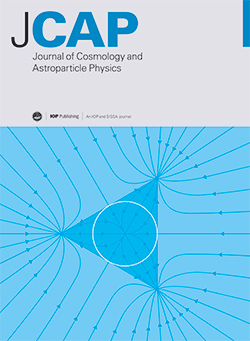Gravitational waves from extreme mass ratio inspirals in Kerr-MOG spacetimes
IF 5.3
2区 物理与天体物理
Q1 ASTRONOMY & ASTROPHYSICS
Journal of Cosmology and Astroparticle Physics
Pub Date : 2025-03-06
DOI:10.1088/1475-7516/2025/03/006
引用次数: 0
Abstract
This work elaborates on a detailed analysis of the novel characteristics of gravitational waves (GWs) generated by extreme mass-ratio inspirals (EMRIs) within the framework of modified gravity (MOG). Our study begins by exploring the geometrical and dynamical properties of the Kerr-MOG spacetime. We employ the numerical kludge (NK) method for waveform simulations and reveal that the parameter α, representing deviations from general relativity (GR), significantly impacts the frequencies of geodesic orbits and, consequently, the EMRI waveforms. However, the waveform confusion problem remains mainly unresolved, posing a challenge in distinguishing between the underlying gravitational theories based on the observed EMRI waveforms. Notably, by incorporating the effects of radiation reaction and increasing the MOG parameter α, we observe a substantial reduction in the waveform overlap over time. This reduction could enhance our ability to discern between different waveforms over an extended period. Our analysis further identifies that α begins to influence energy fluxes at the 1 post-Newtonian (PN) order, highlighting its leading-order effects on the orbital dynamics. Additionally, we find that α becomes detectable when the estimated overlap crosses the detection threshold by computing the mismatch. And we estimate that the detection error for α can be constrained to Δα ≈ 1.85 × 10-4 by using the Fisher information matrix (FIM) method, demonstrating the potential of space-based gravitational wave detectors to probe deviations from GR with high precision.求助全文
约1分钟内获得全文
求助全文
来源期刊

Journal of Cosmology and Astroparticle Physics
地学天文-天文与天体物理
CiteScore
10.20
自引率
23.40%
发文量
632
审稿时长
1 months
期刊介绍:
Journal of Cosmology and Astroparticle Physics (JCAP) encompasses theoretical, observational and experimental areas as well as computation and simulation. The journal covers the latest developments in the theory of all fundamental interactions and their cosmological implications (e.g. M-theory and cosmology, brane cosmology). JCAP''s coverage also includes topics such as formation, dynamics and clustering of galaxies, pre-galactic star formation, x-ray astronomy, radio astronomy, gravitational lensing, active galactic nuclei, intergalactic and interstellar matter.
 求助内容:
求助内容: 应助结果提醒方式:
应助结果提醒方式:


